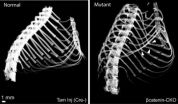(Press-News.org) PHILADELPHIA — Researchers have identified two molecules that could potentially serve as biomarkers in predicting brain metastases in patients with breast cancer, according to data published in Cancer Research, a publication of the American Association for Cancer Research.
Currently, most deaths from breast cancer are a result of metastatic disease. New research shows that cancer stem-like cells — commonly defined as cells within a tumor with the capacity to initiate a new tumor, proliferate rapidly, differentiate and cause chemotherapy resistance — may play a role in breast cancer metastasis.
"Recent research has shown that microRNAs are involved in tumor initiation and progression, and we hypothesized that they also may play a role in metastasis, particularly in relation to cancer stem-like cells," said Kounosuke Watabe, Ph.D., associate director for basic science at the University of Mississippi Medical Center in Jackson, Miss.
Watabe and colleagues performed microRNA profile analysis on RNA extracted from cancer stem-like cells isolated from a human breast cancer cell line and two highly metastatic variants of this cell line.
"We found that miR-7 is a metastasis suppressor in cancer stem-like cells," Watabe said. "When we increased expression of miR-7 in cancer stem-like cells from metastatic human breast cancer cell lines, it suppressed their metastatic properties."
Next, the researchers examined the molecular pathway downstream of miR-7 to find its targets and discovered that miR-7 suppressed expression of KLF4.
"High expression of KLF4 was inversely associated with brain metastasis-free survival but was not associated with bone metastasis," Watabe said. "This was confirmed in an animal model when we found that expression of miR-7 significantly suppressed the ability of cancer stem-like cells to metastasize to the brain but not the bone."
Finally, the researchers tested tumor samples from patients with breast cancer whose disease metastasized to the brain. Results showed that miR-7 was downregulated and KLF4 was upregulated. The miR-7/KLF4 axis played a critical role in cancer stem-like cell brain metastasis, according to Watabe.
Few treatments currently exist for brain metastasis because few drugs can penetrate the blood–brain barrier, which prevents chemotherapy from reaching the brain.
"Cancer cells find the brain to be a kind of sanctuary where they can survive longer," Watabe said. "It is possible that miR-7 and KLF4 may serve as diagnostic or prognostic markers, or therapeutic targets for the prediction of, or treatment of, brain metastasis."
###
Follow the AACR on Twitter: @aacr #aacr
Follow the AACR on Facebook: http://www.facebook.com/aacr.org
About the American Association for Cancer Research
Founded in 1907, the American Association for Cancer Research (AACR) is the world's first and largest professional organization dedicated to advancing cancer research and its mission to prevent and cure cancer. AACR membership includes more than 34,000 laboratory, translational and clinical researchers; population scientists; other health care professionals; and cancer advocates residing in more than 90 countries. The AACR marshals the full spectrum of expertise of the cancer community to accelerate progress in the prevention, biology, diagnosis and treatment of cancer by annually convening more than 20 conferences and educational workshops, the largest of which is the AACR Annual Meeting with more than 17,000 attendees. In addition, the AACR publishes eight peer-reviewed scientific journals and a magazine for cancer survivors, patients and their caregivers. The AACR funds meritorious research directly as well as in cooperation with numerous cancer organizations. As the scientific partner of Stand Up To Cancer, the AACR provides expert peer review, grants administration and scientific oversight of team science and individual grants in cancer research that have the potential for near-term patient benefit. The AACR actively communicates with legislators and policymakers about the value of cancer research and related biomedical science in saving lives from cancer. For more information about the AACR, visit www.AACR.org.
MicroRNA molecule may serve as biomarker, target for brain metastases in breast cancer patients
2013-02-06
ELSE PRESS RELEASES FROM THIS DATE:
Hospice use rises; So does aggressive care
2013-02-06
PROVIDENCE, R.I. [Brown University] — A study published Feb. 6 in the Journal of the American Medical Association finds that while more seniors are dying with hospice care than a decade ago, they are increasingly doing so for very few days right after being in intensive care. The story told by the data, said the study's lead author, is that for many seniors palliative care happens only as an afterthought.
"For many patients, hospice is an 'add-on' to a very aggressive pattern of care during the last days of life," said Dr. Joan Teno, professor of health services policy ...
Lower proportion of Medicare patients dying in hospitals
2013-02-06
In a study that included data on more than 800,000 Medicare beneficiaries who died between 2000 – 2009, a lower proportion died in an acute care hospital in recent years, although both intensive care unit (ICU) use and the rate of health care transitions increased during the last month of life, according to a study appearing in the February 6 issue of JAMA.
"Site of death has been proposed as a quality measure for end-of-life care because, despite general population surveys indicating the majority of respondents and those with serious illness want to die at home, in ...
Use of ACE inhibitor by patients with peripheral artery disease may improve pain-free walking
2013-02-06
Among patients with peripheral artery disease and intermittent claudication (pain in the calf that comes and goes, typically felt while walking), 24 weeks of treatment with the angiotensin-converting enzyme (ACE) inhibitor ramipril was associated with improvement in pain-free and maximum walking times and the physical health aspect of quality of life, according to a study appearing in the February 6 issue of JAMA.
"Approximately 27 million individuals in Europe and North America have peripheral artery disease (PAD). Intermittent claudication occurs in approximately one-third ...
Corticosteroid injection, physiotherapy do not provide significant improvement for 'tennis elbow'
2013-02-06
Among patients with chronic unilateral lateral epicondylalgia ("tennis elbow"), a single injection of corticosteroid medication was associated with poorer outcomes after one year and higher recurrence rates compared with placebo, while eight weeks of physiotherapy did not significantly improve long-term outcomes, according to a study appearing in the February 6 issue of JAMA.
"Use of corticosteroid injections to treat lateral epicondylalgia is increasingly discouraged, partly because evidence of long-term efficacy has not been found, and due to high recurrence rates," ...
Reflex control could improve walking after incomplete spinal injuries
2013-02-06
A training regimen to adjust the body's motor reflexes may help improve mobility for some people with incomplete spinal cord injuries, according to a study supported by the National Institutes of Health.
During training, the participants were instructed to suppress a knee jerk-like reflex elicited by a small shock to the leg. Those who were able to calm hyperactive reflexes – a common effect of spinal cord injuries – saw improvements in their walking.
The study was led by Aiko Thompson, Ph.D., and Jonathan Wolpaw, M.D., both of whom hold appointments at the New York ...
Obesity leads to vitamin D deficiency
2013-02-06
Obesity can lead to a lack of vitamin D circulating in the body, according to a study led by the UCL Institute of Child Health (ICH). Efforts to tackle obesity should thus also help to reduce levels of vitamin D deficiency in the population, says the lead investigator of the study, Dr Elina Hypponen.
While previous studies have linked vitamin D deficiency with obesity, the ICH-led paper, published in the journal PLOS Medicine, sought to establish the direction of causality i.e. whether a lack of vitamin D triggers a weight gain, or whether obesity leads to the deficiency.
This ...
Tourists face health risks from contact with captive sea turtles
2013-02-06
LA, CA (05 February 2013). Tourists coming into contact with sea turtles at holiday attractions face a risk of health problems, according to research published today by JRSM Short Reports. Encountering free-living sea turtles in nature is quite safe, but contact with wild-caught and captive-housed sea turtles, typically through handling turtles in confined pools or through consuming turtle products, carries the risk of exposure to toxic contaminants and to zoonotic (animal to human) pathogens such as bacteria, viruses, fungi and parasites. Symptoms, which may take some ...
Insect drives robot to track down smells
2013-02-06
A small, two-wheeled robot has been driven by a male silkmoth to track down the sex pheromone usually given off by a female mate.
The robot has been used to characterise the silkmoth's tracking behaviours and it is hoped that these can be applied to other autonomous robots so they can track down smells, and the subsequent sources, of environmental spills and leaks when fitted with highly sensitive sensors.
The results have been published today, 6 February, in IOP Publishing's journal Bioinspiration and Biomimetics, and include a video of the robot in action http://www.youtube.com/watch?v=n2k1T2X7_Aw&feature=youtu.be
The ...
Steroids help reverse rapid bone loss tied to rib fractures
2013-02-06
(Embargoed) CHAPEL HILL, N.C. – New research in animals triggered by a combination of serendipity and counterintuitive thinking could point the way to treating fractures caused by rapid bone loss in people, including patients with metastatic cancers.
A series of studies at the University of North Carolina School of Medicine found that steroid drugs, known for inducing bone loss with prolonged use, actually help suppress a molecule that's key to the rapid bone loss process. A report of the new findings appears online Feb. 5, 2013 in the journal PLOS ONE.
Osteoporosis ...
Paternal obesity impacts child's chances of cancer
2013-02-06
Maternal diet and weight can impact their child's health even before birth – but so can a father's, shows a study published in BioMed Central's open access journal BMC Medicine. Hypomethylation of the gene coding for the Insulin-like growth factor 2, (IGF2),in newborns correlates to an increased risk of developing cancer later in life, and, for babies born to obese fathers, there is a decrease in the amount of DNA methylation of IGF2 in foetal cells isolated from cord blood.
As part of the Newborn Epigenetics Study (NEST) at Duke University Hospital, information was collected ...


